7.06.2018
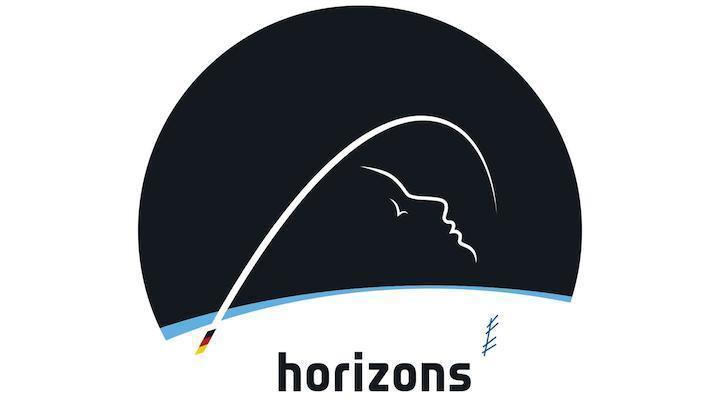
European astronaut set to command ISS launches on Soyuz
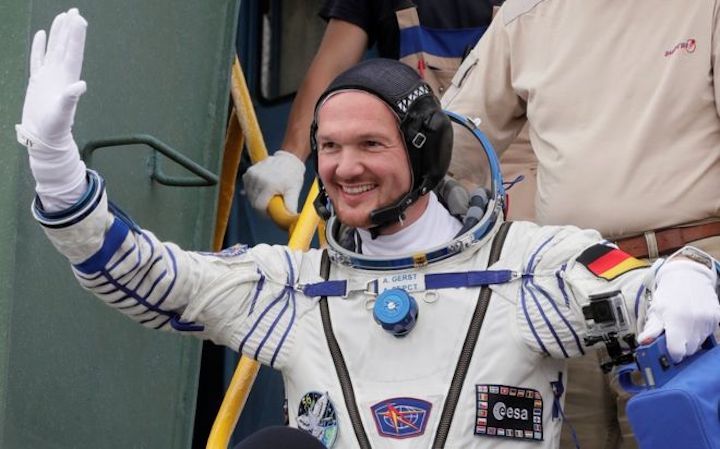
German astronaut Alexander Gerst will be the second European to command the ISS
-
The next European commander of the International Space Station has just blasted off into orbit.
German Alexander Gerst was joined in his Soyuz craft by Russian Sergei Prokopyev and Serena Auñón-Chancellor from the US.
The trio should arrive at the 400km-high outpost on Friday.
Gerst will act as a flight engineer until October, after which he will assume command of the station. He will be only the second European to do so.
The first was Belgian Frank De Winne, who led the crew onboard the ISS in 2009.
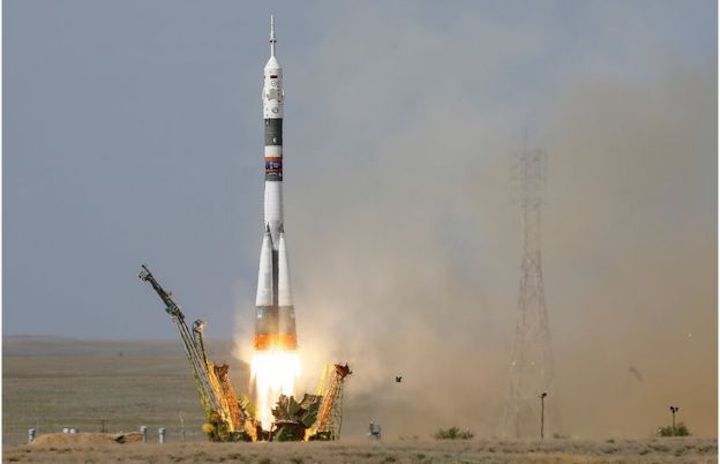
The Soyuz launched just after midday (BST) from Baikonur Cosmodrome in Kazakhstan
.

Mr Gerst is joined on the flight by Sergei Prokopyev and Serena Auñón-Chancellor
-
Gerst's mission is called Horizons. He has 50 bespoke experiments to perform on the orbiting platform.
Every astronaut gets to take up a few items of personal baggage. For the 42-year-old German, a native of Künzelsau, these include a piece of the Berlin Wall - a symbol, he says, of vanishing borders.
Gerst first served on the ISS in 2014. He trained in the same European astronaut class as Briton Tim Peake.
The group call themselves "the Shenanigans".
Gerst's activities can be followed on the European and US space agency websites, and on his Twitter feed, @astro_alex.
In January, Dr Auñón-Chancellor stepped in to replace fellow Nasa astronaut Jeanette Epps, who was originally set to fly on the mission.
Nasa did not give a reason for Dr Epps' withdrawal, but said she would be considered for future missions.
Quelle: BBC
+++
Russian spacecraft with new expedition blasts off to world’s sole orbiter
The manned spacecraft has entered the near-Earth orbit and started its autonomous flight to the orbital outpost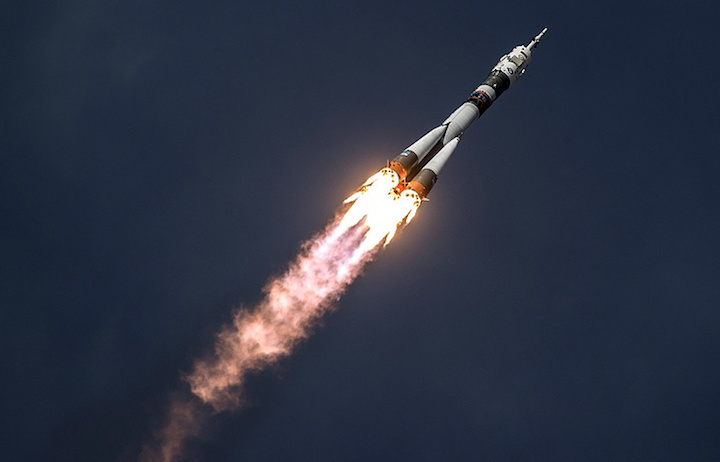
A Soyuz-FG carrier rocket with a manned Soyuz MS-09 spacecraft has blasted off from the Baikonur spaceport in Kazakhstan to the International Space Station (ISS), TASS reports from the scene.
The carrier rocket with the manned spacecraft lifted off from the Baikonur cosmodrome at 2:12 p.m. Moscow time.
The manned spacecraft is carrying Russian cosmonaut Sergei Prokopyev (the Soyuz MS-09’s commander), NASA astronaut Serena Aunon-Chancellor and representative of the European Space Agency (ESA) Alexander Gerst.
The spacecraft’s launch was watched by Russia’s State Space Corporation Roscosmos Head Dmitry Rogozin, ESA Director-General Johann-Dietrich Woerner, US Ambassador to Russia Jon Huntsman and the world’s first woman-cosmonaut Valentina Tereshkova.
The manned spacecraft has entered the near-Earth orbit and started its autonomous flight to the orbital outpost, Roscosmos told TASS.
"The spacecraft separated from the third stage of the Soyuz-FG carrier rocket in the normal regime at the designated time," Roscosmos said.
The manned Soyuz spacecraft will be performing its autonomous flight using a two-day scheme. The spacecraft is scheduled to dock with the ISS at 2:21 p.m. Moscow time on June 8.
The new space expedition’s crew will stay for 187 days aboard the orbital output. Over this period, the crewmembers will be working with the Progress MS and US Dragon resupply ships, performing a program of applied researches and experiments and carrying out spacewalks (specifically, work outside the space station under the Russian program is scheduled for August 8).
Quelle: TASS
+++
Russian space agency installs external video camera on Soyuz spacecraft for first time
In the future, Roscosmos plans to integrate videos from onboard video cameras into most launch companies to popularize space exploration
Russia’s State Space Corporation Roscosmos installed external video cameras on the Soyuz MS-09 spacecraft for the first time to test the methods of visual control over the carrier rocket’s flight, Roscosmos said on Wednesday.
"During the launch on June 6, new methods were tested for the first time to exercise visual control of the space rocket’s flight. An additional external camera is mounted on manned and resupply spaceships, beginning with the Soyuz MS-09 and the Progress MS-09, for visual control (apart from the onboard video control system) during the separation of the third stage from the spacecraft," Roscosmos said in a statement.
"In the future, Roscosmos intends to integrate videos from onboard video cameras into most launch companies to popularize space exploration," the statement reads.
A Soyuz-FG carrier rocket with a manned Soyuz MS-09 spacecraft blasted off from the Baikonur spaceport in Kazakhstan to the International Space Station (ISS) on Wednesday.
The carrier rocket with the manned spacecraft lifted off from the Baikonur cosmodrome at 2:12 p.m. Moscow time.
The manned spacecraft is carrying Russian cosmonaut Sergei Prokopyev (the Soyuz MS-09’s commander), NASA astronaut Serena Aunon-Chancellor and representative of the European Space Agency (ESA) Alexander Gerst.
The spacecraft’s launch was watched by Roscosmos Head Dmitry Rogozin, ESA Director-General Johann-Dietrich Woerner, US Ambassador to Russia Jon Huntsman and the world’s first woman-cosmonaut Valentina Tereshkova.
The manned spacecraft subsequently entered the near-Earth orbit and started its autonomous flight to the orbital outpost, Russia’s State Space Corporation Roscosmos told TASS.
"The spacecraft separated from the third stage of the Soyuz-FG carrier rocket in the normal regime at the designated time," Roscosmos said.
The manned Soyuz spacecraft will be performing its autonomous flight using a two-day scheme. The spacecraft is scheduled to dock with the ISS at 2:21 p.m. Moscow time on June 8.
The new space expedition’s crew will stay for 187 days aboard the orbital output. Over this period, the crewmembers will be working with the Progress MS and US Dragon resupply ships, performing a program of applied researches and experiments and carrying out spacewalks (specifically, work outside the space station under the Russian program is scheduled for August 8).
Quelle: TASS
+++
Soyuz MS-09 Launches U.S., Russian, German Spacefarers to Space Station
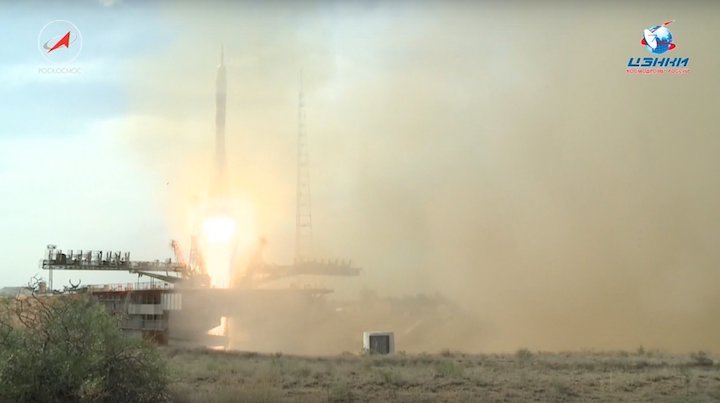
Three spacefarers from three nations—including a former Russian Air Force strategic bomber pilot, the second European commander of the International Space Station (ISS) and a Cuban-American flight surgeon moved in January from the backup to the prime crew—have launched from the Baikonur Cosmodrome in Kazakhstan, aboard Soyuz MS-09. Sergei Prokopiev, Alexander Gerst and Serena Auñón-Chancellor rocketed away from Site 1/5 at the historic launch site at 5:12 p.m. local time (7:12 a.m. EDT) Wednesday, 6 June, bound for a six-month increment on the orbiting outpost. They will initially form the second half of Expedition 56, helmed by U.S. astronaut Drew Feustel, before Gerst rotates into the command of Expedition 57 in October, leading the station until his own crew returns to Earth in mid-December.
For the third consecutive occasion, a Soyuz crew will embark on a longer rendezvous approach to get to the ISS, spending two days and 34 orbits in transit, due to phasing constraints. The Soyuz MS-08 crew followed a similar profile in March 2018, as did their predecessors aboard Soyuz MS-07, last December. Not since Soyuz MS-06 in September 2017 has a crew followed the shorter, six-hour and four-orbit “fast rendezvous” approach. “08 and 09…happen to be scheduled on dates that do not allow phasing for the four-orbit rendezvous,” NASA’s Rob Navias told AmericaSpace, earlier this year. “Four-orbit rendezvous are desirable, but by no means mandatory.” Depending upon the launch date, it is anticipated that the Soyuz MS-10 flight of Russian cosmonaut Alexei Ovchinin and U.S. astronaut Nick Hague in the fall will follow a shorter rendezvous profile.

Watched closely by his crewmates, Alexander Gerst completes the traditional ritual of signing his bedroom door in the Baikonur Cosmonaut Hotel. Photo Credit: ESA/Twitter
-
Gerst, a German citizen, is the only veteran member of the Soyuz MS-09 crew, having previously flown for 165 days during Expeditions 40/41 in May-November 2014. Assignment to his second mission came in May 2016, with the expectation that he would be the second European Space Agency (ESA) astronaut to command the station, after Belgium’s Frank de Winne, who led Expedition 21 in the closing months of 2009. Last year, Gerst announced that his upcoming mission will be named “Horizons”. When asked about the name, he explained that horizons “are a symbol for the unknown and when I gaze at the horizon, I cannot help but wonder what lies beyond it”. ESA Director General Jan Woerner added that the Horizons name was fitting, “as it will open up new horizons in human and robotic spaceflight”.
In January 2017, NASA astronaut Jeanette Epps was assigned to join Gerst aboard Soyuz MS-09, together with cosmonaut Sergei Prokopiev. The three served as backups for last December’s Soyuz MS-07 crew, ahead of their own launch in mid-2018. However, a few weeks later, Epps was abruptly dropped from the crew—for reasons which remain unclear—and replaced by her backup, Auñón-Chancellor. Pre-flight exams concluded on 11 May, after which the prime crew and their backups—Russia’s Oleg Kononenko, together with “rookies” David Saint-Jacques of the Canadian Space Agency (CSA) and Anne McClain of NASA—flew from the Star City cosmonauts’ training center, near Moscow, to Baikonur, on 19 May. Over the following days, they participated in customary activities, including raising U.S., Russian, German and Kazakh flags, and the rookies planted their own trees in Baikonur’s Avenue of Cosmonauts. This provided an opportunity for a spot of humor for Gerst, whose own tree appeared rather sorry for itself, as did the tree of his former Expedition 40/41 crewmate Reid Wiseman. “Hey @astro_reid,” Gerst tweeted on 22 May, “glad there are some things we are better at than planting trees.”
As much as Gerst was looking forward to his mission, there were some things he would miss. “Last night, breathtaking thunderstorm above Baikonur; my absolute favorite weather,” he tweeted on 31 May. “Lightning across entire sky. Stood out there in the rain for two hours & watched the storm sweep across the dark steppe, towards launch pad. Last rain for half-year? I will miss this planet!”

The crew waves to wellwishers before entering Soyuz MS-09. Photo Credit: NASA/Twitter
-
On 1 June, the Soyuz MS-09 spacecraft, encapsulated within its payload shroud, was transported by rail to Baikonur’s integration facility and placed atop the 162.4-foot-tall (49.5-meter) Soyuz-FG booster. Emblazoned with imagery pertaining to this year’s FIFA World Cup in Sochi, Russia, the rocket was taken to Site 1/5 in a horizontal configuration on 4 June. The nod to the World Cup was particularly relevant, as Gerst’s homeland of Germany are currently the defending champions. However, Gerst was not there. Nor was Auñón-Chancellor. And nor was Prokopiev. Instead, the backup crew of Kononenko, Saint-Jacques and McClain witnessed the rollout. “Soyuz is being rolled out to the launch pad,” tweeted Saint-Jacques. “The prime crew is forbidden to attend because it could bring bad luck.” From his crew quarters, Gerst agreed. “Only the replacement crew can watch,” he tweeted. “Perhaps because someone is afraid that we will think differently…?” Other astronauts were in attendance, too, including former shuttle commander Mark Polansky, who now supports NASA and Commercial Space as an aerospace executive. Also there was Sigmund Jähn, who became Germany’s first national spacefarer, flying to the Soviet Union’s Salyut 6 space station, way back in the summer of 1978. Now a sprightly 81 years old, Jähn was spotted chatting to veteran cosmonaut Pavel Vinogradov.
Earlier today, the prime and backup crews were awakened in Baikonur’s Cosmonaut Hotel. They showered, breakfasted on oatmeal, then submitted to disinfecting and microbial sampling in support of the ISS research investigations that they will perform on-orbit. After ceremonially autographing the doors of their hotel rooms and receiving a blessing from a Russian Orthodox priest, the prime crew proceeded via bus to Site 254 to don their Sokol (“Falcon”) launch and entry suits. “Have gotten a great farewell from friends and family,” Gerst tweeted at 11:30 a.m. local time (1:30 a.m. EDT), some 5.5 hours before launch. “Mood in the crew is great. Observe uninterested camels along the wayside.” They then headed out to the launch pad. Prokopiev was inserted into the center commander’s seat of Soyuz MS-09’s descent module, with Gerst taking up his own position in the Flight Engineer-1 seat on the left side of the vehicle and Auñón-Chancellor assuming the right seat as Flight Engineer-2. “Hissing, almost like a living creature,” was Gerst’s description of the venting Soyuz-FG.
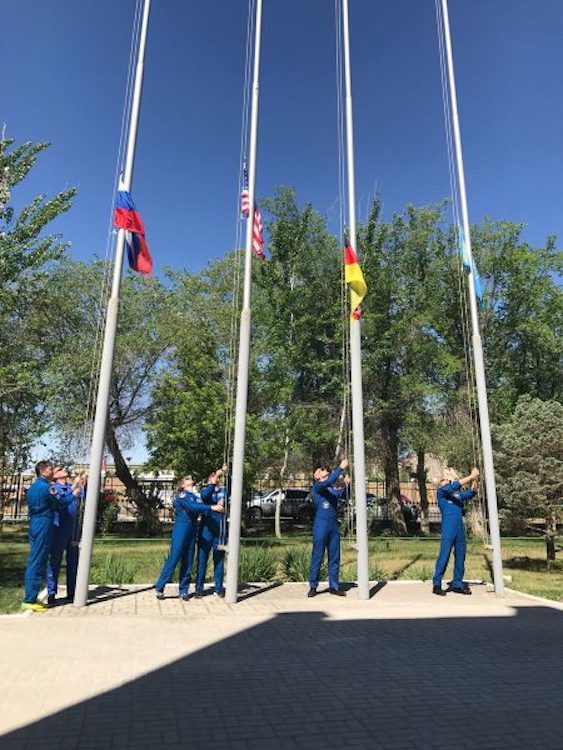
The prime and backup crews raise the national flags of Russia, the United States, Germany and Kazakhstan. Photo Credit: NASA/Twitter
-
As is traditional, the final phase of the countdown saw music, selected by the crew, piped into the Soyuz cabin. Last month, Gerst tweeted a request for suggestions. “On the launch pad, one hour before launch, during pressure checks, the crew gets to listen to music over the radio,” he explained. After soliciting recommendations, he added a caveat: “Nope, they won’t play “big balls of fire”. Really!”
Already loaded aboard the Soyuz-FG was a highly refined form of rocket-grade kerosene, known as “RP-1”, with liquid oxygen being continuously topped-off until close to T-0, to ensure that boiled-off cryogens were kept replenished and maintained at “Flight Ready” levels. At 4:57 p.m. local time (6:57 a.m. EDT), with about 15 minutes to go, the Launch Abort System (LAS) was armed and transferred to Automatic Mode and the three crew members were instructed to close their space suit visors.
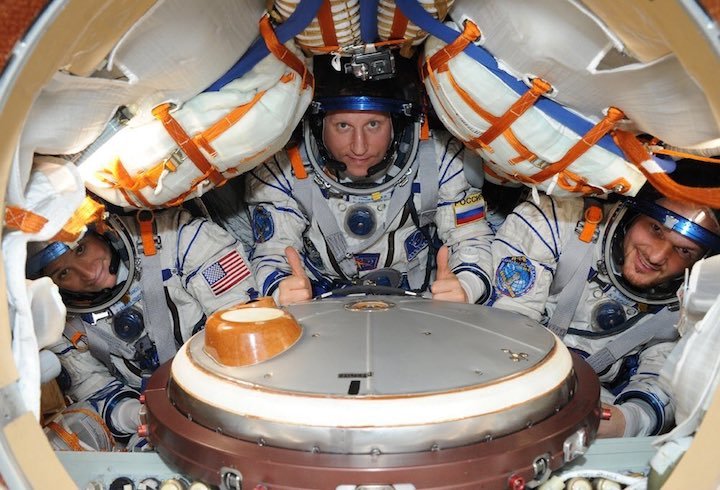
The Soyuz MS-09 prime crew, pictured in their spacecraft during pre-launch fit checks. From left to right are Serena Auñón-Chancellor, Sergei Prokopiev and Alexander Gerst. Photo Credit: RKK Energia/Serena Auñón-Chancellor/Twitter
-
At T-5 minutes, Prokopiev’s controls were activated and internal avionics aboard Soyuz MS-09 were spooled-up to monitor booster systems throughout ascent. From within the control bunker, the “launch key”—an actual, physical key—was inserted to enable the booster’s ordnance. “It’s a good thing that I was not in charge of the #LaunchKey,” tweeted former NASA astronaut and Soyuz veteran Cady Coleman. “Keeping track of keys never my strength!”
Propellant tanks were pressurized and it was transferred from ground support utilities onto internal power, with the twin umbilical towers retracting away from the vehicle. Ten seconds before T-0, the turbopumps of the RD-108 first-stage engine and the RD-107 engines of the Soyuz-FG’s four tapering, strap-on boosters attained full speed. Five seconds later, the engines themselves ignited and ramped up to full power, before Site 1/5’s fueling tower retracted and Soyuz MS-09 roared into the late-afternoon Baikonur sky.
With the four tapering boosters and the central core powering the initial launch phase, a total of five engines punched out a combined total of 930,000 pounds (422,000 kg) of thrust to lift the 672,000-pound (305,000 kg) rocket away from Earth and onto a two-day voyage to reach the space station.
Less than two minutes into the flight, the strap-on boosters were exhausted and jettisoned, by which point Prokopiev, Gerst and Auñón-Chancellor were traveling in excess of 1,100 mph (1,770 km/h). Interestingly, today’s launch marked the first occasion that a Soyuz-FG had been fitted with an external camera to monitor “staging” in real-time. With both boosters gone, the Soyuz-FG core continued to burn, until the RD-108 shut down a little under five minutes after liftoff. At the instant of shutdown, the rocket and its crew had attained an altitude of 105.6 miles (170 km).
Next came the turn of the third stage, which executed a so-called “Hot Stage” burn, igniting its single RD-0110 engine whilst still attached to the core. A few seconds later, the 89-foot-tall (27.1-meter) core stage was jettisoned. The third stage pushed Soyuz MS-09 to a velocity in excess of 13,420 mph (21,600 km/h) and burned for four minutes, until it shut down at eight minutes and 45 seconds into the flight. By the time of RD-0110 cutoff and the separation of the 22-foot-long (6.7-meter) third stage, Soyuz MS-09 had attained a preliminary orbit with an apogee of 143 miles (230 km) and a perigee of 118 miles (190 km), inclined 51.66 degrees to the equator.
The trio will now spend two days in transit, before Prokopiev guides his ship to a docking at the Earth-facing (or “nadir”) Rassvet module of the station at 9:07 a.m. EDT on Friday, 8 June, whereupon they will bring the resident crew team up to six members, joining Expedition 56 Commander Drew Feustel and Flight Engineers Ricky Arnold and Oleg Artemyev. The new arrivals will have little time to acclimatize, though, as U.S. EVA-51 by Feustel and Arnold is scheduled for 14 June. During the course of their six-month increment, Prokopiev, Gerst and Auñón-Chancellor are expected to support around 300 experiments across a variety of scientific and technological disciplines and welcome two SpaceX Dragon cargo ships in June and November, two Russian Progress vehicles in July and November, Japan’s H-II Transfer Vehicle (HTV)-7 in August and the unpiloted test-flights of SpaceX’s Crew Dragon in August and Boeing’s CST-100 Starliner in November.

Remarkable view of Soyuz MS-09 from external cameras, shortly before the deployment of the twin solar arrays. Photo Credit: ESA/Twitter
-
A Russian EVA by Artemyev and Prokopiev is targeted for August, followed by several U.S. EVAs in the the September timeframe. Over a two-year period, from 2017-2019, it is expected that 48 aging nickel-hydrogen batteries on the port-side and starboard-side of the station’s massive Integrated Truss Structure (ITS) will be replaced with 24 small, yet higher-performing lithium-ion batteries. In January 2017, across a pair of EVAs, Expedition 50 spacewalkers Shane Kimbrough, Thomas Pesquet and Peggy Whitson worked to install six batteries into the starboard-side S-4 truss, with the batteries for Power Channels 2A and 4A in the station’s port-side P-4 truss expected to receive attention in the fall 2018 EVAs. The new batteries will ride uphill aboard Japan’s HTV-7 in August.
When Feustel, Arnold and Artemyev return to Earth in early October, Gerst will take command of the ISS and officially kick off Expedition 57. A few days later, on 11 October, Soyuz MS-10 will launch from Baikonur, carrying Ovchinin and Hague. Original plans envisaged a three-man crew but ongoing delays in the launch of Russia’s Multipurpose Laboratory Module (MLM) have caused unfortunate “rookie” cosmonaut Nikolai Tikhonov to be dropped from an ISS prime crew for the second time in less than two years. According to NASA’s Rob Navias, there are no plans for the vacant third seat to be taken by an additional U.S. crew member.
Moving forward, it is expected that ISS expeditions will run for 180-200 days apiece—about a month longer than standard—as NASA and the International Partners ready themselves for the test-flights and Post-Certification Missions (PCMs) of the Commercial Crew Program. Assuming that Prokopiev, Gerst and Auñón-Chancellor land on time on 13 December, they will log a mission of about 190 days. “We and Roscosmos agreed to extend the increments to about 180 days or so,” Mr. Navias told AmericaSpace, “to ensure that we will be making a seamless inclusion of CCP flights to blend in with Soyuz operations.”
Quelle: AS
---
Update: 8.06.2018 / 7.35 MESZ
.
Alexander Gerst ist zum zweiten Mal erfolgreich auf dem Weg zur ISS

- Der deutsche ESA-Astronaut ist am 6. Juni 2018 um 13.12 Uhr MESZ zusammen mit der NASA-Astronautin Serena Aunon-Chancellor und dem Kosmonauten Sergei Prokopjew zu seiner zweiten Langzeitmission ins All aufgebrochen.
- Die Ankunft des Sojus-Raumschiffs an der ISS ist für den 8. Juni vorgesehen.
- Schwerpunkte: Raumfahrt, Gesundheit und Gesellschaft, Klimawandel, Industrie 4.0 und Digitalisierung
Am 18. Mai 2016 hatte die Europäische Weltraumorganisation ESA bekannt gegeben, dass der deutsche ESA-Astronaut Alexander Gerst nach seiner erfolgreichen Blue-Dot-Mission aus dem Jahre 2014 einen zweiten Raumflug absolvieren wird. Vor einem guten Jahr, am 29. Mai 2017, hat Alexander Gerst seine neue Mission "horizons" dann selbst vorgestellt. Heute, am 6. Juni 2018, ist der 42-jährige Geophysiker gemeinsam mit seinen Crew-Kollegen, der NASA-Astronautin Serena Maria Aunon-Chancellor, und dem russischen Kosmonauten Sergei Prokopyev, planmäßig um 13.12.41 Uhr Mitteleuropäischer Sommerzeit (MESZ, 17.12.41 Uhr Ortszeit) an Bord des Sojus-Raumschiffs MS-09 vom russischen Kosmodrom in Baikonur (Kasachstan) zur Internationalen Raumstation gestartet.
"Deutschland ist seit 40 Jahren ein fester Bestandteil der internationalen astronautischen Raumfahrt. Seit der Mission Sojus 31 mit Sigmund Jähn haben zehn weitere deutsche Kosmonauten und Astronauten im Auftrag der Wissenschaft hunderte von Experimenten in der Erdumlaufbahn durchgeführt", betont Prof. Pascale Ehrenfreund, Vorstandsvorsitzende des DLR. "Egal ob Forschung und Entwicklung oder Raumfahrtmanagement - das DLR steht mit technologischen Kompetenz und wissenschaftlichen Exzellenz sowie seinen internationalen Partnern für die gemeinsame erfolgreiche Arbeit auf der Internationalen Raumstation - die mit Alexander Gerst auf der Horizons-Mission die Arbeit der vergangenen 40 Jahre fortführt."
Für Gerst ist es der zweite Langzeitaufenthalt auf der ISS - bis zum 13. Dezember 2018 soll der Deutsche als Missionsspezialist im größten Forschungslabor außerhalb der Erde in 400 Kilometern Höhe leben und arbeiten. Der gebürtige Baden-Württemberger - Gerst stammt aus dem hohenlohischen Künzelsau - soll insgesamt 67 europäische Experimente absolvieren, davon stammen 41 aus Deutschland. Ab Oktober soll Alexander Gerst auch als erster Deutscher Kommandant der ISS sein. Der ESA-Astronaut gehört zu den ISS-Expeditionen 56 und 57. Das Deutsche Zentrum für Luft- und Raumfahrt (DLR) ist für die Auswahl und Koordination der deutschen Experimente und der deutschen Beiträge zur ISS verantwortlich.
Alexander Gerst, Serena Aunon und Sergei Prokopjew haben die letzten Tage vor ihrem Raumflug in der Kosmonauten-Unterkunft am Kosmodrom in Baikonur verbracht. Sie haben eine ganze Reihe von Zeremonien und Ritualen durchlaufen, wie die Vorbesichtigung "ihrer" Sojus-Kapsel und die Segnung der Rakete, den Besuch des Stadtmuseums in Baikonur und des Cosmodrom-Museums inklusive des Hauses des russischen Kosmonauten Juri Gagarin, der 1961 als erster Mensch ins All flog. Serena Aunon und Sergei Prokopjew haben zudem an der Allee der Kosmonauten jeweils einen Baum gepflanzt, für beide ist es der erste Flug ins All. Alle drei Astronauten haben auf der Tür zum Zimmer von Gagarin unterschrieben und am Abend vor dem Start traditionell der sogenannten State Kommission mit Vertretern von Roskosmos, NASA, ESA und DLR Bericht erstattet und sich persönlich von ihren Familien verabschiedet. Ein gemeinsamer Friseurbesuch stand ebenso auf dem Programm wie das Anziehen der Sokol Start-Anzüge und Abfahrt von Gebäude 254 rund drei Stunden vor dem Start. Etwa zwei Stunden vor dem Start nahmen Gerst, Aunon und Prokopjew ihre Plätze in der Sojus-Rakete ein, die dann vom Launchpad, auf dem auch Juri Gagarin bei seiner Mission 1961 gestartet war, pünktlich abhob.
Prokopjew ist ausgebildeter Pilot und Kommandant des Sojus-Raumschiffs, das nun auf dem Weg zur ISS ist und die Raumstation nach 48 Stunden am 8. Juni um 15.07 Uhr MESZ erreichen soll. "Das Sojusraumschiff braucht diesmal zwei Tage, oder 34 Orbits, weil die Unterschiede in Bahnebene und Phasenwinkel zur ISS für einen 4-Orbit Transfer zu groß sind. Deshalb benötigt die Sojus für die ganzen Bahnänderungsmanöver mehr als vier Orbits (oder sechs Stunden), um diesen Abstand aufzuholen", erläutert Volker Schmid, horizons-Missionsleiter im DLR, den längeren Flug. Um 16.50 Uhr MESZ soll sich am 8. Juni die Luke zwischen Sojus-Kapsel und Raumstation öffnen und die Crew kann in die ISS einschweben.
Quelle: DLR
+++
FOLLOW THE DOCKING OF ESA ASTRONAUT ALEXANDER GERST
ESA astronaut Alexander Gerst was launched into space on 6 June at 11:12 GMT (13:12 CEST) alongside Roscosmos commander Sergei Prokopyev and NASA astronaut Serena Auñón-Chancellor. Watch the docking live with commentary by ESA astronaut Matthias Maurer.
The trio blasted off from Baikonur cosmodrome, Kazakhstan and will arrive at the International Space Station two days later, marking the start of Alexander’s Horizons mission.
After 34 orbits of Earth, ESA astronaut Alexander Gerst will arrive at the International Space Station on 8 June at 13:07 GMT (15:07 CEST). His Soyuz spacecraft will dock with the Station's Rassvet module. The hatch will open about two hours later, marking the start of the Horizons mission. This will be Alexander’s second spaceflight. He will also be the second ESA astronaut to take over command of the International Space Station. The Horizons science programme is packed with European research: over 50 experiments will deliver benefits to people on Earth as well as prepare for future space exploration.
A German-language broadcast of the launch, direct from the Zeiss-Großplanetarium in Berlin, Germany, can be viewed here.
6 June 2018
| Liftoff | 11:12 GMT | 13:12 CEST |
8 June 2018
| Docking coverage starts | 12:15 GMT | 14:15 CEST |
| Docking | 13:07 GMT | 15:07 CEST |
| Hatch opening coverage starts | 14:30 GMT | 16:30 CEST |
| Hatch opening | 15:05 GMT | 17:05 CEST |
Quelle: ESA
+++
+++ Also Leute: 8. Juni / 14Uhr15 MESZ Beginn der Liveübertragung zum Andocken von @Astro_Alex und Crew auf http://www.nasa.gov +++ Docking 15Uhr07 +++ Öffnen der Luke und "Betreten" der Station ca. 16Uhr30 +++ Danach "Willkommen an Bord" mit allen Crewmitgliedern.
Quelle: DLR
+++





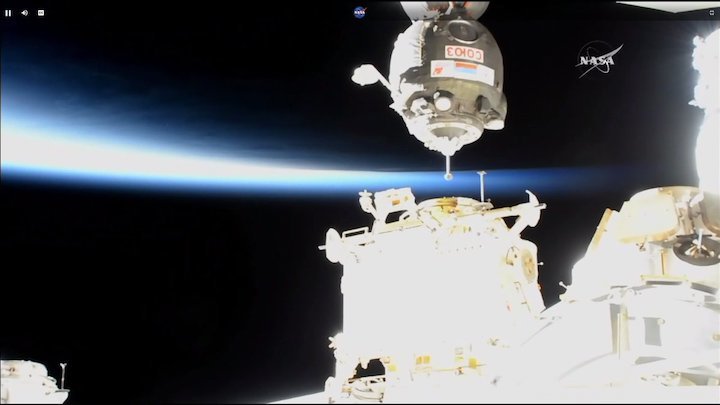

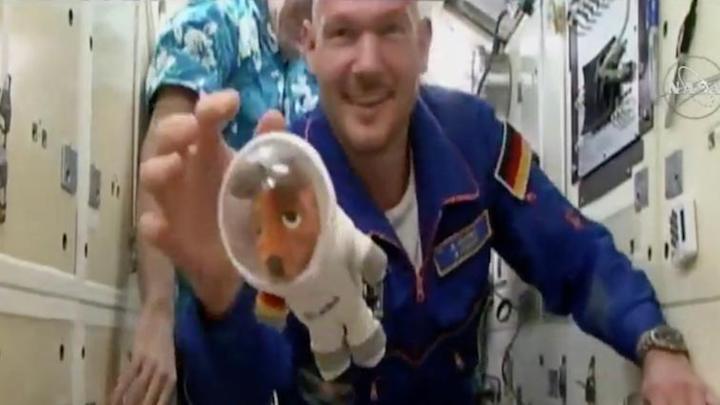

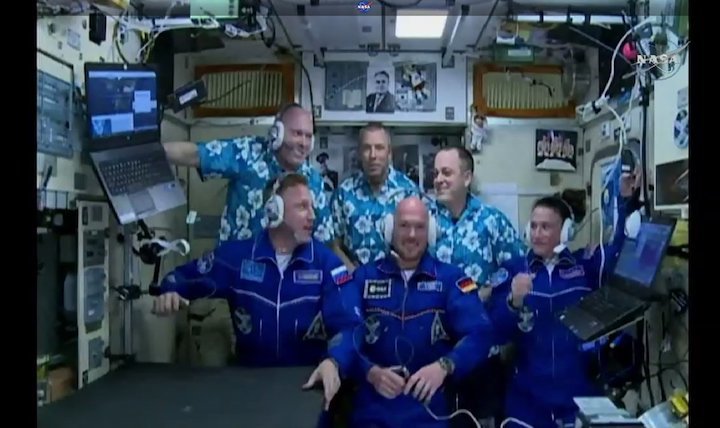
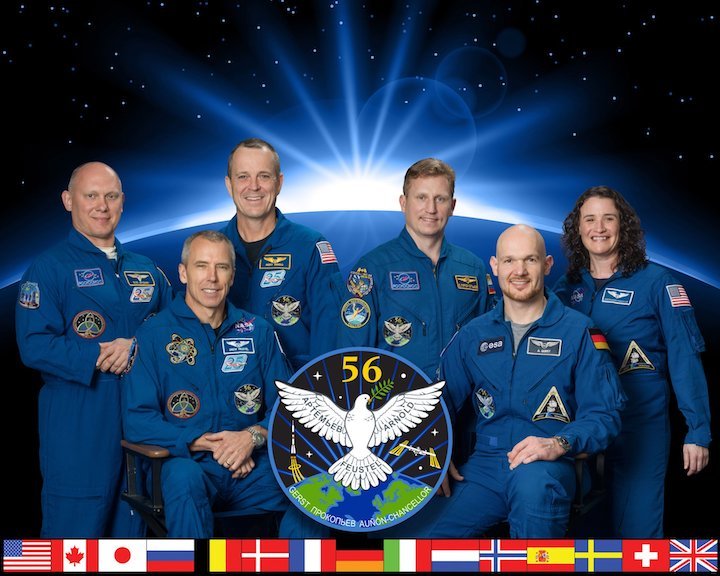
Quelle: NASA, ESA
---
Update: 9.06.2018
.
New Crew Arrives at the International Space Station
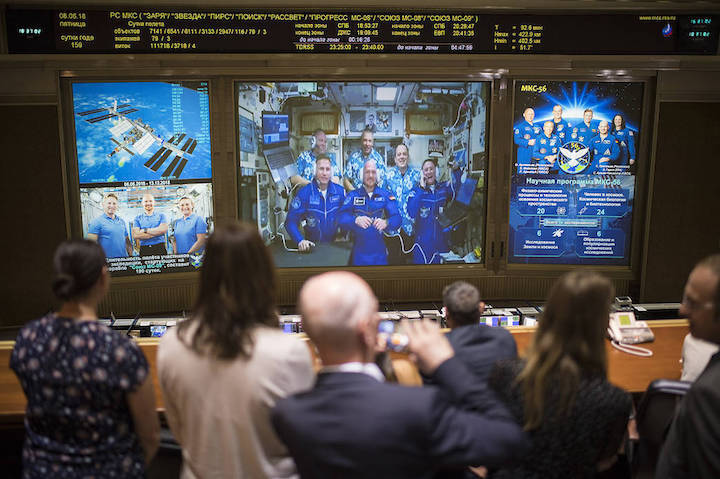
Expedition 56 astronauts Sergey Prokopyev of Roscosmos, bottom left, Alexander Gerst of the European Space Agency, bottom center, and Serena Auñón-Chancellor of NASA, bottom right, are seen with astronaut Oleg Artemyev of Roscosmos, top left, Commander Drew Feustel of NASA, top center, and astronaut Ricky Arnold of NASA, top right, are seen on a video monitor as they talk to family and friends at the Moscow Mission Control Center in Korolev, Russia a few hours after the Soyuz MS-09 docked to the International Space Station on Friday, June 8, 2018. Hatches were opened at 11:17 a.m. EDT (6:17pm Moscow time).
-
Rückblick vor Start:








Quelle: NASA
---
Update: 11.06.2018
.
Researchers to Discuss Science Launching on Next Resupply Mission to Space Station

NASA will host a media teleconference at 2 p.m. EDT Monday, June 11, to discuss a number of science investigations launching to the International Space Station on the next SpaceX commercial resupply mission. Audio of the teleconference will stream live on NASA’s website.
David Brady, assistant program scientist for the International Space Station Program at NASA’s Johnson Space Center, and Liz Warren, associate program scientist at the Center for Advancement of Science in Space (CASIS), will provide an overview of the research and technology aboard SpaceX’s Dragon spacecraft.
Also participating in the briefing will be:
- John Hogan, NASA’s Ames Research Center – principal investigator for the Micro-12 investigation, will discuss this cellular biology research on how microgravity affects the growth, gene expression and ability of a model bacterium to transfer electrons through its cell membrane along bacterial nano wires it produces. Such bacteria could be used in microbial fuel cells to make electricity from organic waste.
- Paul Jaminet, founder and chief executive officer, and Shou-Ching Jaminet, chief scientist, Angiex – will discuss Angiex's investigation of endothelial cells, the cells that line the walls of blood vessels. Culturing endothelial cells in microgravity could create an important model system for evaluating the action of any vascular-targeted drug. Use of this model may enable Angiex to develop a novel cancer therapy with lower toxicity and potential to be effective against most cancers.
- Fred Turek and Martha Vitaterna, Northwestern University – principal investigators for Rodent Research-7, will discuss their research to examine how the space environment affects the community of microorganisms in the gastrointestinal tract of mice (also known as the microbiota). Results could help protect astronaut health during long-term missions by providing insights into the microbial populations’ interactions with physiological systems including the gastrointestinal, immune, metabolic, circadian, and sleep systems during spaceflight.
- Mark Settles, University of Florida – principal investigator for the Space Algae investigation, will discuss research to select algae strains adapted to space and sequence their genomes to identify growth-related genes. Algae consume waste carbon dioxide, can provide basic nutrition and may perceive microgravity as a trigger to produce algae oils rich in antioxidants that may help mitigate the harmful effects of microgravity and cosmic radiation during spaceflight.
To participate in the teleconference, media must contact Stephanie Schierholz at 202-358-1100 or stephanie.schierholz@nasa.gov no later than noon on June 11, for dial-in information.
SpaceX is targeting no earlier than 5:41 a.m. June 29 for the launch of its Dragon spacecraft on a Falcon 9 rocket from Space Launch Complex 40 at Cape Canaveral Air Force Station in Florida.
The Space Life and Physical Sciences Research and Applications Division at NASA Headquarters in Washington is sponsoring the Micro-12 and Rodent Research-7 investigations as part of its research to enable human spaceflight exploration, and CASIS is sponsoring the Angiex Cancer Therapy and Space Algae investigations as part of the U.S. National Laboratory research to improve life on Earth.
Quelle: NASA
---
Update: 13.06.2018
.
Alexander Gerst findet es „fantastisch“ auf der ISS

Mit an Board: ein WM-BALL. Den will Astro-Alex der DFB-Elf bei einem Sieg überreichen
-
Vier Tage nach seiner Ankunft auf der Internationalen Raumstation ISS geht es Alexander Gerst dort „fantastisch“. Die Ankunft am Freitag habe sich „wirklich so angefühlt, als ob ich hier nicht mal weg gewesen wäre“, sagte der deutsche Astronaut bei seiner ersten Pressekonferenz aus dem All.
„Selbst das Schweben klappt – mir ist nicht schlecht geworden, keine Weltraumkrankheit.“ Auch erste Experimente habe er schon gemacht.
„Die Reise hier hoch war eine andere als beim letzten Mal“, sagte Gerst. „Ich hatte mehr Verantwortung.“ Als Kopilot habe er in der Sojus-Kapsel sehr viel arbeiten müssen und kaum nach draußen schauen können.
Dies habe dazu geführt, „dass die Romantik so ein bisschen gefehlt hat bei diesem Flug“, sagte Gerst. „Die kommt vielleicht später, wenn ich ein bisschen mehr Zeit habe, mal aus dem Fenster zu schauen – ganz wegbleiben tut sie natürlich nicht.“
Das Gespräch mit Gerst wurde in das Astronautenzentrum der Europäischen Weltraumagentur ESA in Köln übertragen. Gerst war zwei Tage nach dem Start in Baikonur am Freitag zu seinem zweiten Langzeitaufenthalt auf der ISS eingetroffen.
Der als Astro-Alex bekannt gewordene 42-Jährige wird bis Dezember auf der ISS bleiben und im Oktober das Kommando der Raumstation übernehmen. Seine Mission stellte er unter das Motto „Horizons“.
„Wir schauen beim Abendessen, wenn wir Zeit haben, mal ein bisschen rein”, sagte Gerst außerdem in der Live-Übertragung. Dabei ließ er auch einen originallizensierten WM-Ball durchs Bild schweben.
„Die Stimmung ist super in der Crew”, schwärmte er. „Man muss sich das hier vorstellen wie einen Campingurlaub: Man hat viel Spaß, aber nicht ganz so viel Komfort.”
Quelle: Bild

